Lecture 4 - Cognitive Development 1 - Piaget
1/77
There's no tags or description
Looks like no tags are added yet.
Name | Mastery | Learn | Test | Matching | Spaced |
|---|
No study sessions yet.
78 Terms
Who is Jean Piaget?
Pioneer in the domain of cognitive development of children.
How does Cognition develop according to Piaget?
Universally fixed order of phases → Discontinuous development.
Each phase qualitatively different.
What is the role of the child in Cognitive development according to Piaget?
Child actively contributes to own knowledge formation (‘little scientist’).

What are the 4 phases of Cognitive development?
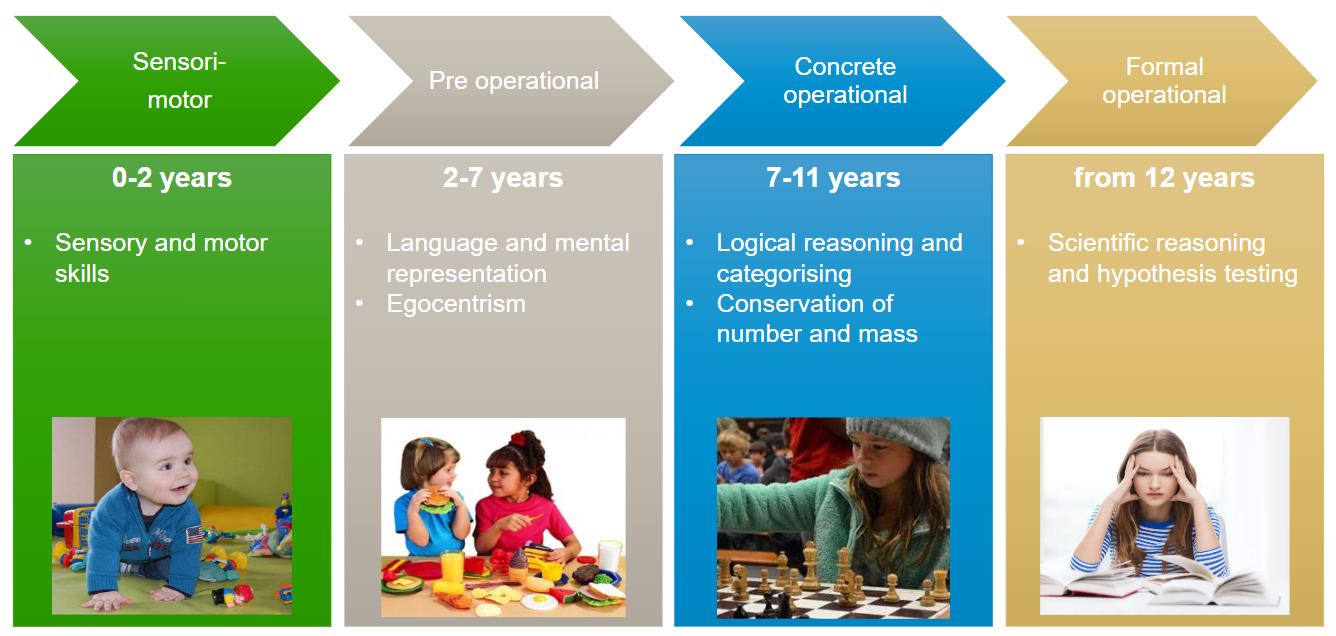
What is a schema?
Building blocks of knowledge (piece of knowledge).
ex. You know that a cat is furry, has a tail and 4 paws.
What is Assimilation?
Existing schema is used in new situation.
assimilate new information into your old schema.
ex. orange thing with a tail and 4 paws is a cat.
assimilation in babies: applying motor schema in new situation.
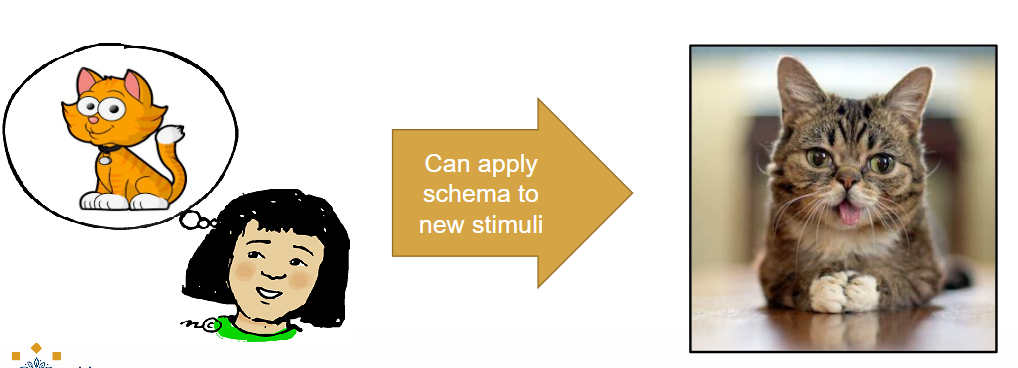
What is Accomodation?
When the existing schema does not work, the schema needs to be changed to deal with a new situation.
ex. we learn that a cat does not necessarily have to have fur for it to be a cat.

What is Equilibration?
Balance between assimilation and accommodation.
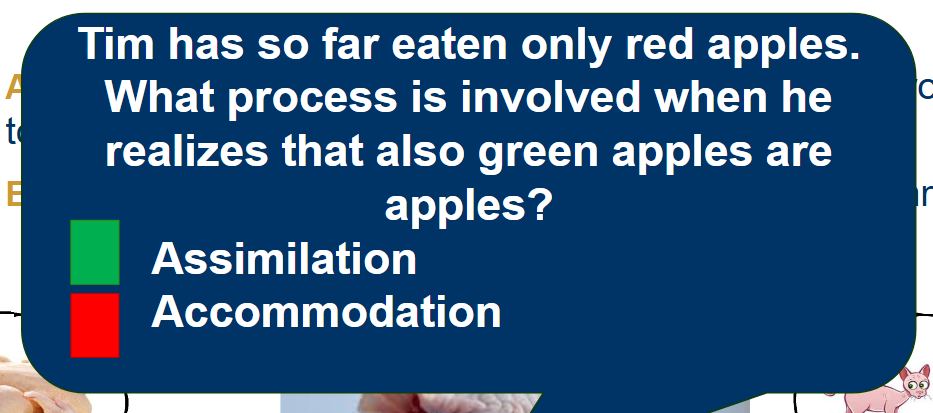
Accomodation
What age is for the Sensori-motor stage? What happens in this stage?
0-2 years: Sensory and motor skills.
Learning about the world via senses and motor skills.
e.g. putting things in their mouth, crawling.
Cannot imagine the intentions, emotions and expectations (mental states) of others.
Circular responses: Develop through repetitive behavior patterns.
What are the 6 substages in the Sensorimotor stage?
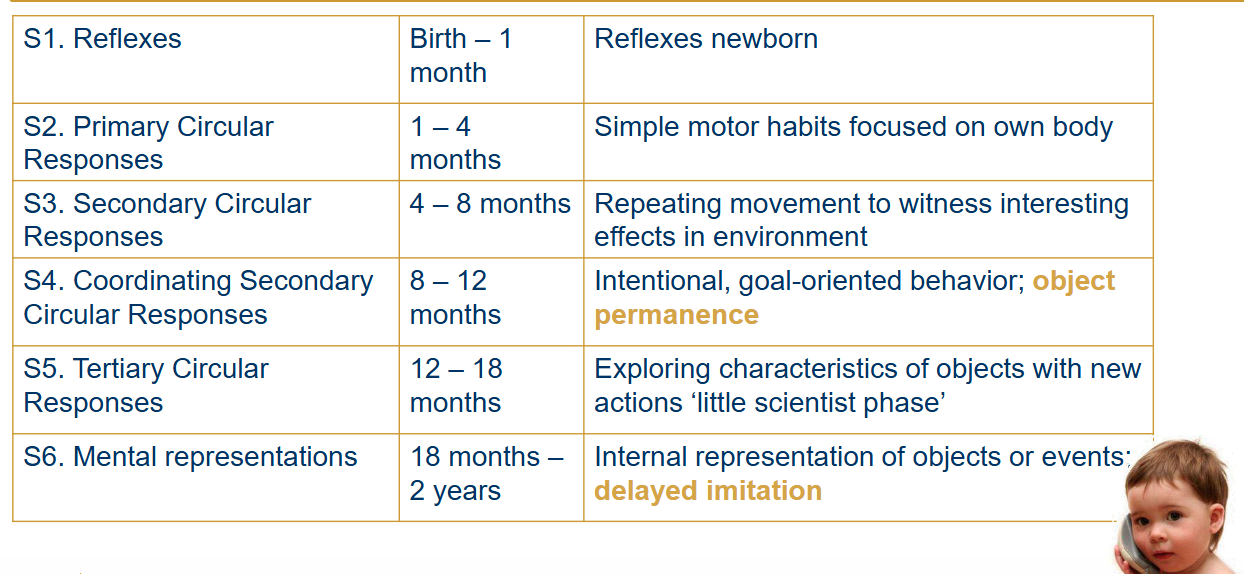
What age do Primary circular responses happen? What happens in this stage?
1-4 months: Simple motor habits focused on own body.
What age do Secondary circular responses happen? What happens in this stage?
4-8 months: Repeating movement to witness interesting effects in environment.
ex. Baby drops a ball and looks at the ball.
What age do Coordinating secondary circular responses happen? What happens in this stage?
8-12 months: Intentional, goal-oriented behavior; object permanence.
ex. Baby moves chair out of the way to get to the playground.
What age do Tertiary circular responses happen? What happens in this stage?
12-18 months: Exploring characteristics of objects with new actions, ‘little scientist phase’.
What age do Mental representations happen? What happens in this stage?
18 months - 2 years: Internal representation of objects or events: delayed imitation.

Coordinating Secondary Circular Responses.
At what stage does Object permanence develop?
Sensorimotor stage.
What is Object permanence?
Understanding that something exists when it is out of sight.
What age do the first signs of Object permanence show?
Around 9 months.
How is Object permanence tested?
By A-not-B error.
What age does Object permanence fully develop?
Around 1 year.
How does Piaget explain the A-not-B error? What are other factors that could play a role?
As immature object permanence.
But memory, inhibition, planning and positive reinforcement (e.g. via ‘baby talk’) may also play a role.
Piaget’s sensorimotor stage: Summary
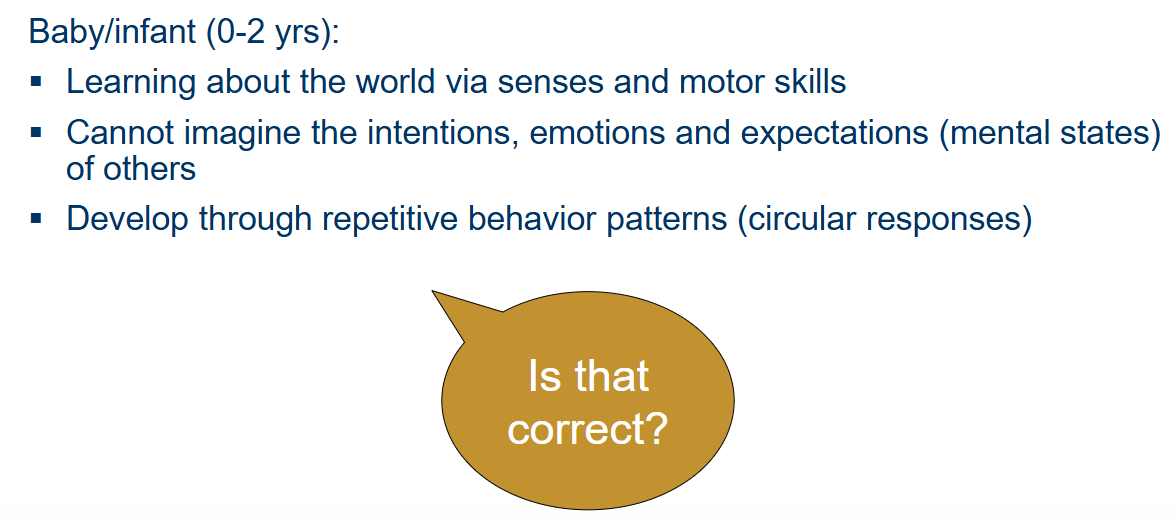
What are 3 Critiques of Piaget’s theory? How has our approach changed?
Underestimated abilities of infants
Infants grasp the basics of physical reality
well before age 1 (Piaget lacked advances
methods)
Understanding of physical reality develops
gradually not in huge qualitative stages
→ Now rather information processing
approach: thinking is divided into specific
steps and processes, much like a computer.
What did Meltzoff research?
Imitation of newborns; babies are able to mimic parent’s facial expressions from a very young age.

What has research on cognition of babies shown about the skills babies have < 1 year?
At <1 year babies already show basic understanding of laws of nature (gravity, volume, continuity of movement).
After a violation of expectancy → babies tend to look longer after unexpected outcome.

How does research show that infants in the sensorimotor stage (0-2 years) understand more than Piaget thought? Name 3 findings.
They already show basic insight in laws of nature.
They already show basic insight in emotions and intentions of others.
They start imitating (much) earlier than Piaget thought.
What happens in the Preoperational stage? What age are the children?
The young child (2-7 years)
Learns to use symbols and language
Language = product of cognitive development.
Intuitive reasoning (‘magical’ thinking)
Lack of conservation (does not use the same logics as adults about the world).
Views the world from an egocentric perspective.

False
Language is driving development → Vygotsky: language can support a child
Language is the product → Piaget: by looking at language, we see what a child can do
When does Symbolic capacity emerge? What does it refer to?
Emerges at end of sensori-motor stage → Advancements of preschoolers:
Use of words to refer to things, people, and events that are not physically present
Ability to refer to past and future
Pretend or fantasy play flourishes : chairs can stand for a train, role plays
What stage does intuitive reasoning develop? What does it entail?
Preoperational stage.
Preschoolers’ use of primitive reasoning and their avid acquisition of world knowledge.
Curiosity blossoms: “Why?” questions central.
At the same time
• Explanation of world with own logic
• Their intuitive thought leads them to confidently believe that they know answers to all kinds of questions
What are the 5 types of Causal understanding of preschoolers?
• Feelings of participation: Child participates dynamically in the actions of nature → accompanied by beliefs in magic
• Animism: Things are conscious and alive
• Artificialism: everything is willed, intentional and organized for the good of man
• Finalism: Everything has an explanation
→ Transductive reasoning: Combining unrelated facts leading to draw faulty cause–effect conclusions simply because two events occur close together in time or space

What is the causal understanding of Feelings of participation?
Child participates dynamically in the actions of nature → accompanied by beliefs in magic.
What is the causal understanding of Animism?
Things are conscious and alive.
What is the causal understanding of Artificialism?
Everything is willed, intentional and organized for the good of man.
What is the causal understanding of Finalism?
Everything has an explanation.
What is the causal understanding of Transductive reasoning?
Combining unrelated facts leading to draw faulty cause-effect conclusions simply because two events occur close together in time or space.
From what does Magical thinking arise? What does this phase entail?
• Consequence of animism: to be afraid in the dark and imagining monsters and seeing living things in your room
• Phase in which children have nightmares, difficult to calm down
• Sensitive to phantasies → in both positive and negative ways
What is the consequence of Magical thinking?
Consequence: imaginary companion
• 28% of the 3- and 4-year-olds report to play with an imaginary friend
• Lasts into school-age years
• Positive consequences:
Advanced cognitive and social development, higher levels of creativity and imagery use
More engagement in private speech than other children
What does the Conservation test measure? What can we say about this about children in the preoperational stage?
Understanding that certain properties (volume/number/weight) remain identical despite changes in their appearance.
Children in the preoperational phase (3-4 years) do not have a notion of conservation.
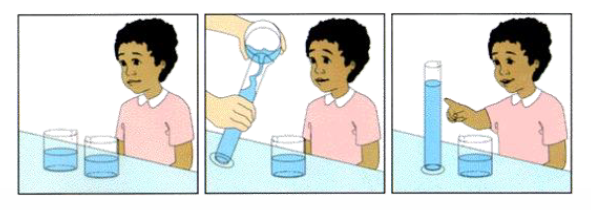
What are 3 reasons why children in the [X] stage do not understand conservation?
Preoperational stage.
1. Centering: attention goes to visually most salient parts → attention centered on single aspect of a problem
2. Irreversibility: not able to mentally reverse change
3. Static thought: thought is fixed on end states rather than the changes that transform one state into another
What is an example of lack of conservation?
No understanding of identity constancy: people remain their essential selves despite changes in how they appear.

What does it mean when we say that a child views the world from an egocentric perspective? What phase does this occur?
= the inability to understand that other people have different points of view ... they do not realize that what is in their mind is not in everyone else’s.
Preoperational stage.
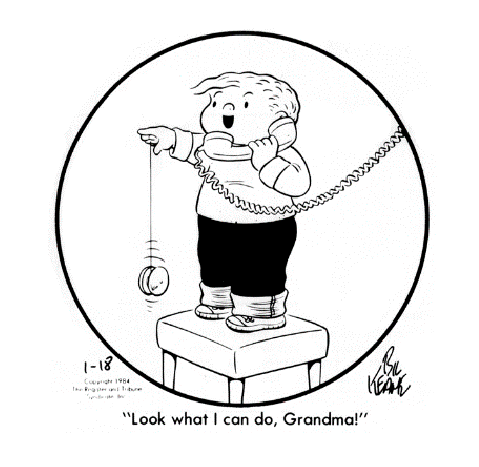
What does Egocentric perspective lead to?
Egocentric conversations typically found in preschool children.
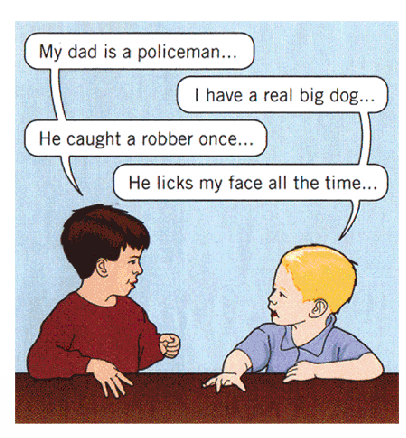
What classic test was used to measure Egocentric perspective?
Three mountains test.
“What does the doll see?”
Children receive 10 pictures with different views.

What results does the Three mountains test by Piaget & Inhelder (1956) show about children’s egocentric perspective?
• 4 year: own perspective
• 7 year: correct other perspective
Conclusion: Children have an egocentric perspective until 7 years
What are the 2 Criticisms on the Three mountains test? What is an alternative experiment that was created?
Criticism of Three mountains test:
• Complex test (chosing from 10 pictures of mountains)
• Material not adapted to child’s life
→ Alternative experiment: “Hide the boy doll from the police men”
• Most 4-year-olds do well!

What happens in the Concrete operational stage? What age are the children?
Children 7-11 years.
Realistic understanding of the world
Logic reasoning, but only in concrete situations (not yet abstractly in a “scientific” way.
Conservation
Classification
Seriation
Transitivity
Classification — What stage? What does it entail?
Concrete operational stage
Understanding of class inclusion: logical understanding that parts are included in the whole.
Classic test: are there more dogs or more animals in this picture?
Answer preoperational stage: dogs
Answer concrete operational stage: animals
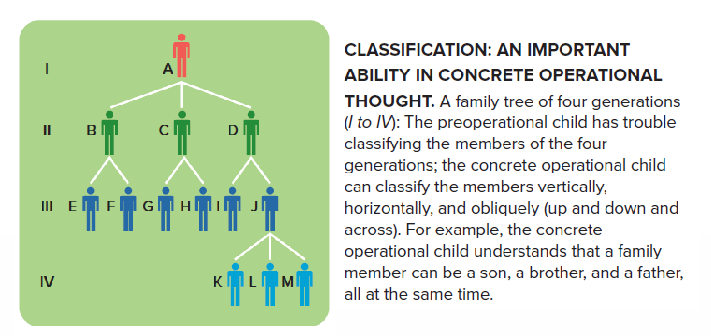
Seriation — What stage? What does it entail?
Concrete operational stage
Sorting things in ‘logical’ order, fe. From short to highest (size, color, shape, type).
It helps children organize thoughts and solve problems logically, which is important for their learning and understanding of how the world works.
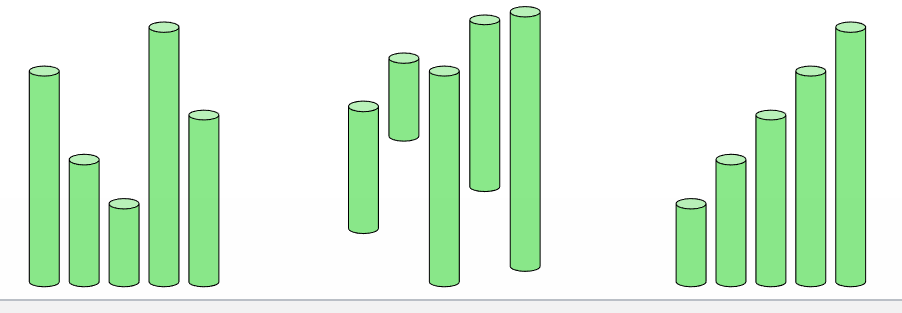
Transitivity — What stage? What does it entail?
Concrete operational stage
Ability to logically combine relations to reach certain conclusions.
Reasoning about the relations between elements in a series.
To draw conclusions based on information that was already presented.
Classic test: Transitivity task
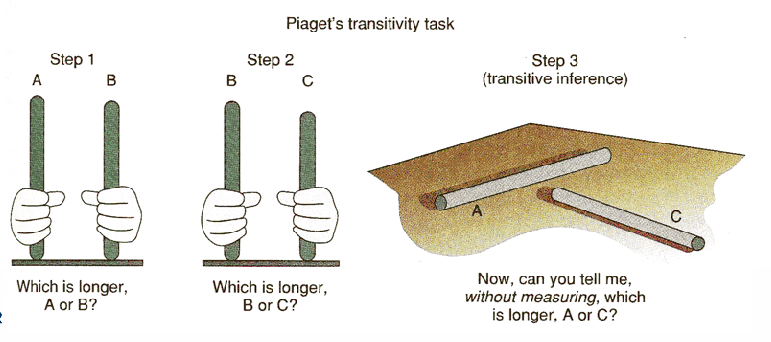
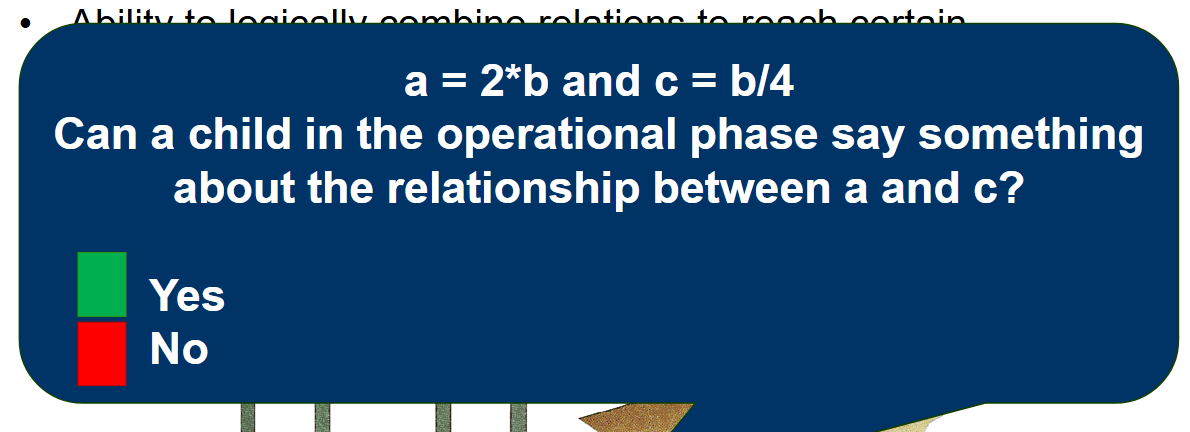
No, because child cannot learn about abstracts yet.
What are the 4 transitions in skills from the Preoperational stage to the Concrete operational stage?
Failing conservation task → Solving conversation tasks
Perceptual salience → Logical reasoning
Transductive reasoning → Inductive reasoning
Egocentrism → Less egocentrism
Single classification → Multiple classification

What is the change from the Preoperational stage to the Concrete operational stage with regard to Conservation tasks?
Preoperational: Fails conservation task because they have:
Irreversible thought — Cannot mentally undo an action.
Centration — Center on a single aspect of a problem rather than two or more dimensions at once.
Static thought — Fail to understand transformations or processes of change from one state of another.
Concrete operational: Solve conservation tasks because they have:
Reversibility of thought — Can mentally reverse or undo an action.
Decentration — Can focus on two or more dimensions of a problem at once.
Transformation of thought — Can understand the process of change from one state to another.
Why do children in the Preoperational stage fail the conservation task? Give 3 reasons.
Irreversible thought — Cannot mentally undo an action.
Centration — Center on a single aspect of a problem rather than two or more dimensions at once.
Static thought — Fail to understand transformations or processes of change from one state of another.
How are children in the Concrete-operational stage able to solve conservation tasks? Give 3 reasons.
Reversibility of thought — Can mentally reverse or undo an action.
Decentration — Can focus on two or more dimensions of a problem at once.
Transformation of thought — Can understand the process of change from one state to another.
How does Understanding change from Preoperational thinkers vs.
Concrete operational thinkers.
Preoperational: Perceptual salience
Understanding is driven by how things look rather than derived from logical reasoning.
Concrete operational: Logical reasoning
Children acquire a set of internal operations that can be applied to a variety of problems.
How does Reasoning change from Preoperational to Concrete operational stage?
Preoperational: Transductive reasoning
Children combine unrelated facts, often leading them to draw faulty cause-error conclusions simply because two events occur close together in time or space.
Concrete-operational: Inductive reasoning
Children draw cause-effect conclusions logically, based on factual information presented to them.
How does Egocentrism change from Preoperational to Concrete operational stage?
Preoperational stage: Egocentrism
Children have difficulty seeing things form other perspectives and assume that what is in their mind is also what others are thinking.
Concrete-operational: Less egocentrism
Children understand that other people may have thoughts different from their own.
How does Classification change from Preoperational to Concrete operational stage?
Preoperational: Single classification
Children classify objects by a single dimension at one time.
Concrete-operational: Multiple classification
Children can classify objects by multiple dimensions and can grasp inclusion.
What are 4 developmental milestones reached in Early childhood: ages 3-6 (preschool and kindergarten)?
• Entering the world of play (pretending)
• Developing language
• Tethered to their immediate perceptions
• Curiosity, try to explain the world
What are 4 developmental milestones reached in Middle childhood: ages 7-11/12 (elementary school)?
Inductive reasoning → Logic closer to the one of adults
• Less egocentric view of the world
• Due to advancements in inductive reasoning: developments in strategy usage, resulting in better memory (see next lecture)
What happens in the Formal operational phase? What age group is this?
From 12 years.
Scientific reasoning and hypothesis testing
From concrete operations (on observable objects) to formal operations (imperceptible ideas) → hypothetical and abstract thinking.
Classic task: Third eye task
Abstract thinking
Think logically
What does the Third eye task entail? In what stage is this?
„If you could have a third eye and put it anywhere on your body, where would you put it, and why?”
Formal operational stage
What type of thinking do we see in the Formal operational phase?
• Adolescents can think like scientists → hypothetical-deductive reasoning
Hypothetical deliberations (“Assuming that...”)
Systematically exploring possible realities (“What would happen if ... ?”)
• Adolescent Egocentrism: heightened self-consciousness
Imaginary audience
Personal fable
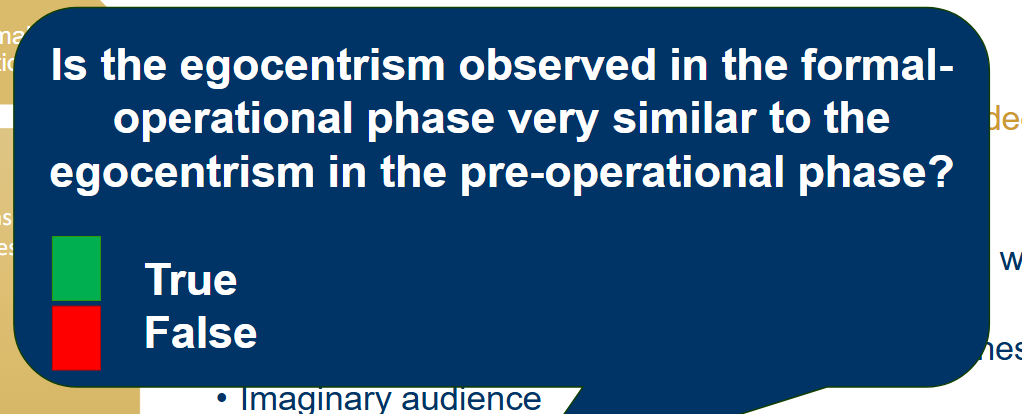
False
pre-operational stage: see everything from own eyes.
formal-operational stage: think that all eyes are on you.
What is the difference between Early and Late formal operations?
• Younger adolescents:
Simple hypothetical propositions
Struggle solving a problem or systematically generate and test hypotheses
• Older adolescents:
Still only 50-60% of tasks testing scientific reasoning correctly solved
Bias: evidence consistent with preexisting beliefs rather accepted than evidence inconsistent with these beliefs
... but some adults never become formal operational thinkers
Formal operations — 4 Relevance for transition to adulthood
• Behaving like adults:
Approach problems in a systematic way and have independent control of complex situations
• High school curricula adapted to new skill:
Understand a poetic metaphor, understand chemistry experiment, debate controversial/moral issues
• Thinking about identity (who am I am?), planning for future (what do I want to become?), better understanding of other people, better appreciation of humor
• Questioning → confusion and rebellion against whatever does not seem
logical enough → idealistic thinking, inventing perfect worlds and envisioning logical solutions to problems
Are formal operations fully achieved in adulthood?
* Only about half of all American college students master Piaget’s scientific reasoning tasks → also show better grades
• Cultural differences: in some societies, no adults able to solve tasks
→ Solving formal tasks linked to intelligence and, more importantly, formal education
→ Difference between areas of expertise: if expert: formal operations, if outside their expertise: concrete operations
What does expertise have to do with the stages of Piaget?
If expert → Formal operations.
If outside their expertise → Concrete operations.
What is Post-formal thought?
Suggested as stage after formal operational phase
More complex way of thinking than in the formal operational stage:
1. Understanding that knowledge is relative, not absolute; there are far more shades of gray than there are clear dichotomies of knowledge.
2. Accepting that the world (physical and mental) is filled with contradictions: inconsistent information can exist side by side.
3. Attempting to integrate the contradictions into some larger understanding.
What 2 types of thinking does Post-formal thought show up as?
1. Relativistic thinking: conclusions depend on context and perspective, multiple solutions
Many people start as absolutists, become relativists, and finally make commitments to positions
2. Dialectic thinking: detecting paradoxes and inconsistencies among ideas and trying to reconcile them
What is Post-formal thought fostered by?
• Fostered by environments that expose us to a wider range of ideas, roles, and experiences (e.g., greater diversity among friends)
• Adult thought may indeed be different or more advanced than the formal-operational thought of adolescence, but is not officially considered as fifth stage of Piaget
What is the relationship of Aging and Piaget’s tests?
Older adults often have trouble solving Piagetian tests of formal-operational thinking (and sometimes even on the concrete- operational tasks).
Do older adults go backwards in the stages of Piaget?
Many studies cross-sectional: less formal education in older adults
Relevance of skills: unfamiliar problems, more linked to tasks at school but not everyday-relevant → motivation?
Age-related decline in operational abilities not firmly established!
What are 4 Criticisms of Piaget’s theory?
• Restricted research method
Studied his own three children
• Underestimated children’s skills
• Language as product of cognitive development (not cause)
• Underestimated influence of social environment
Nature-nurture interaction: Teaching promotes cognitive growth
Summary Lecture 4
